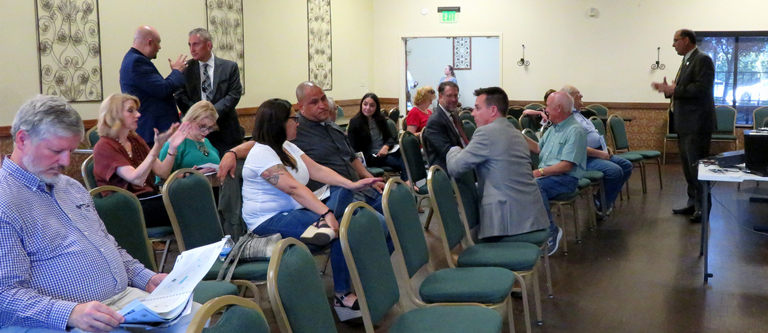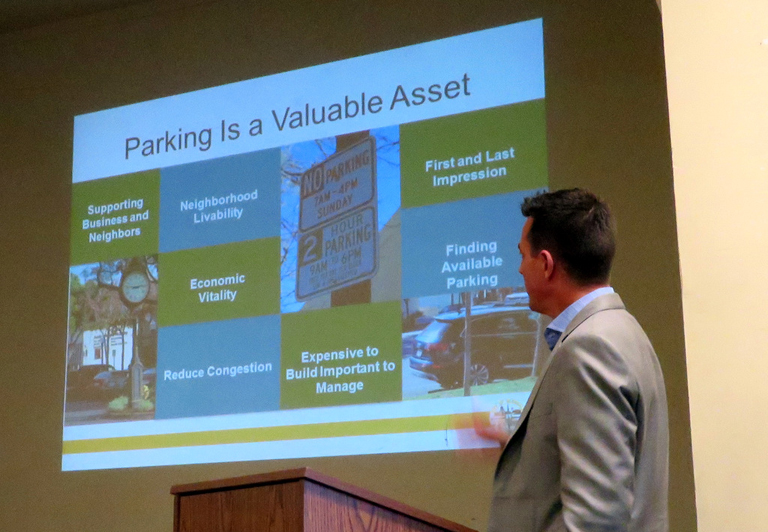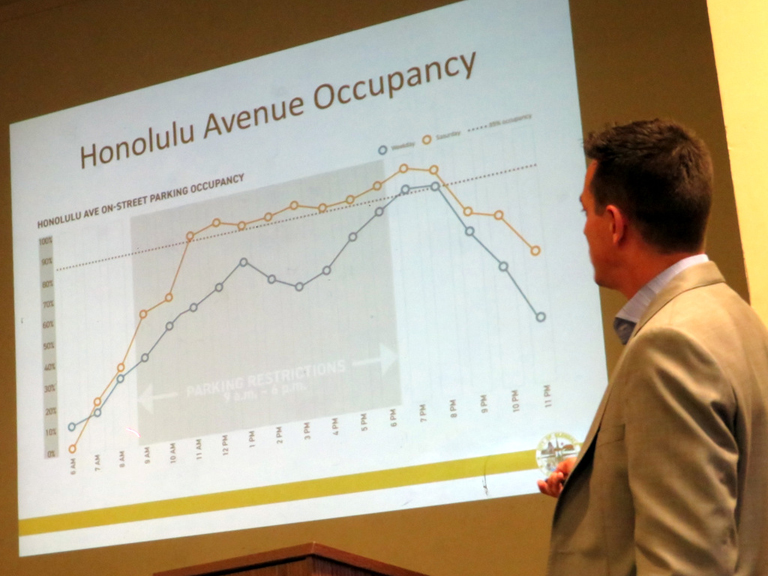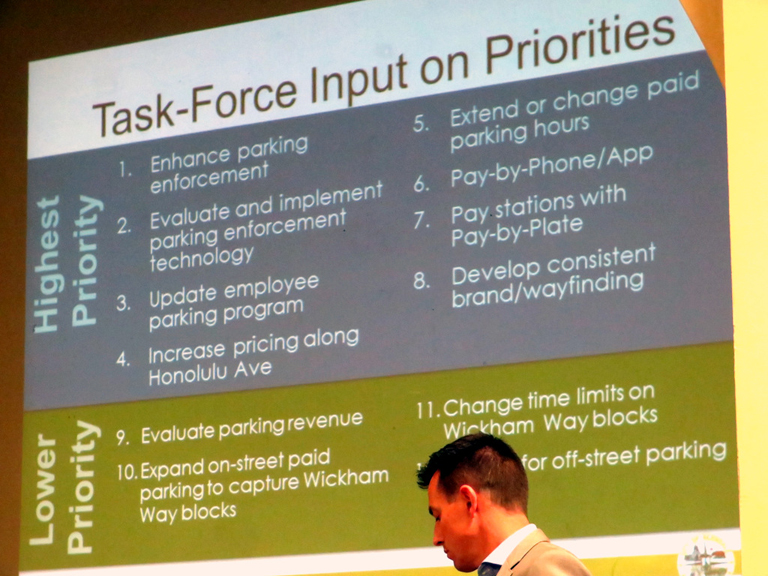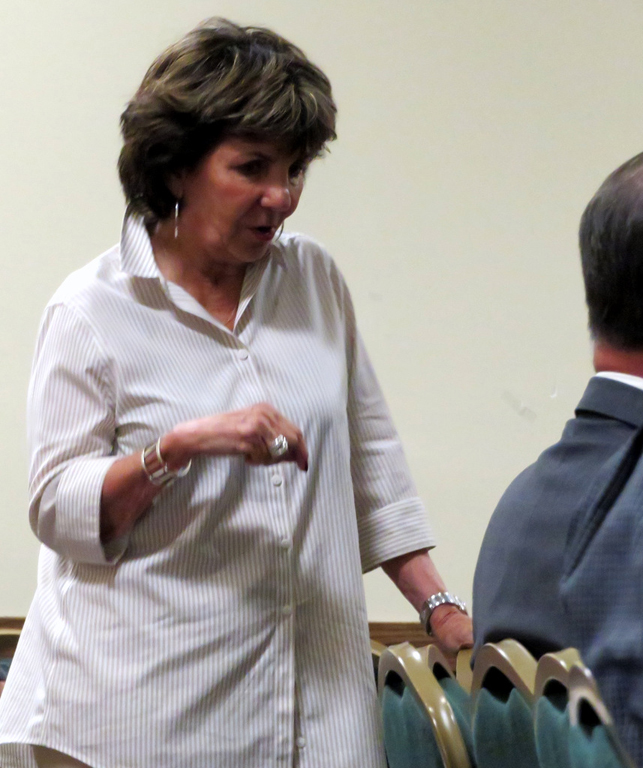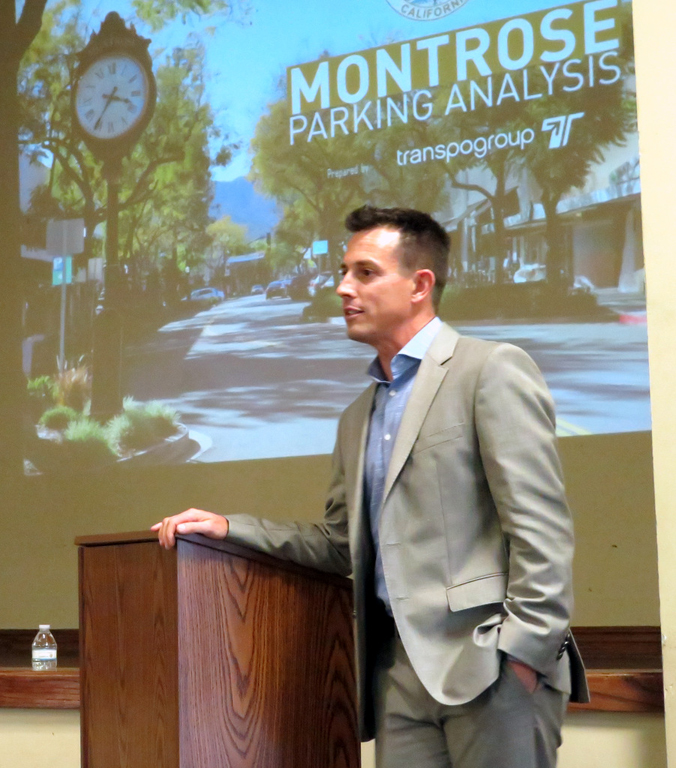
Traffic engineer Dan McKinney of the Transpo Group shared a summary of the study.
By Julie BUTCHER
The Montrose Parking Task Force shared the results of their work on parking in the Montrose Shopping Park area at a community meeting on Thursday, Aug. 29 and announced next steps, including short and long-term strategies.
Charging for off-street parking is the last action proposed, a last resort, task force members assured the business owners at the meeting.
Parking task force chair and president of the Montrose Shopping Park Association (MSPA) Andre Ordubegian introduced the consultant hired by the city to assist the committee in analyzing current and future parking trends and needs. Traffic engineer Dan McKinney of the Transpo Group based in Kirkland, Washington, introduced himself, presented his credentials and identified himself as a “data nerd” and traffic engineer, then shared a summary of the study.
Glendale Transportation manager Tad Drambowski expressed support for the approach and findings of the study.
“Before this, we didn’t even know how many parking spaces we had. To know that there are 787 spaces in Montrose is a great start,” he said.
According to study documents, the overall vision guiding the analysis is to “enhance customers’ experience in [the] Montrose Shopping Park through a commitment to maintaining and improving public infrastructure including parking, landscaping and public furniture.”
Parking is a critical asset, McKinney began. If managed well, good parking strategies support businesses and neighbors, enhance the livability and economic vitality of the community, and reduce traffic congestion. Thirty percent of urban traffic is attributed to drivers circling while looking for parking.
Parking is expensive to build, the consultant continued, and important to manage; it affects the first and last impressions of shoppers and visitors.
Advocating for a “data-driven” approach to parking decisions to “best optimize valuable parking assets, balance occupancies, and to influence demand to meet transportation, economic, and livability goals,” McKinney added that type of analysis ideally results in parking that is convenient and accessible to local businesses. Congestion at peak times can be abated, reducing driver frustration and leading to a more positive parking experience.
Input from the task force underpinned the study: The unique character of Montrose is important. The committee wants local businesses to grow and to expand their customer base and believes the focus should be on ensuring parking is available for employees and customers. To that end, the committee agreed to update and participate in a now moribund employee parking program. The task force also wants revenue generated from parking enhancements to be reinvested back into Montrose.
Finally, the study group commended the positive involvement of Glendale Community College (GCC) for its participation in the work of the task force as well as for its community-mindedness in opening up its parking for the Harvest Market vendors. GCC expects to continue to expand its facilities in Montrose.
The task force identified the highest priorities: enhanced parking enforcement; the evaluation and implementation of parking enforcement technology; updating the employee parking program; increasing pricing at the meters along Honolulu Avenue; extending and/or changing the paid parking hours; adding pay-by-phone, pay stations, and new “pay-by-plate” options; and adding new consistent branding and wayfinding signage.
Lower priorities identified by the group are to evaluate parking revenue; expand on-street paid parking to capture the Wickham Way blocks and to change the time limits on Wickham Way; and, finally, to begin to charge for off-street parking.
Parking that is lower than 70% full, McKinney explained, feels empty and uninviting. When more than 85% of the spots are filled, on the other hand, parking feels full and unavailable. The “sweet spot” is between 70% and 85%. Pricing changes are made to encourage drivers to park in less utilized spots and lots.
“We consider paid parking when we’re at 85% occupancy for four or more hours in a day,” McKinney explained the standards that are used in the parking industry, “to shift choices.”
Steps have already been taken to increase parking enforcement in Montrose. Meter parking on Honolulu Avenue will increase .50 an hour (up from the current rate of $1 per hour) and the coin-operated meters will be updated to allow for payment by phone and soon by way of license plate recognizing software.
Recognizing that the busiest parking times are weekday evenings and weekend days, the times of parking enforcement are recommended to move from 9 a.m. to 6:00 p.m. to 10 a.m. to 8 p.m.
Once these changes have been implemented, the consultant recommends that the city “evaluate shifts in occupancy and make data-driven pricing adjustments on an annual basis, including considering tiered pricing approaches when expanding paid areas.”
“It’s a slow process,” Ordubegian commiserated with the Montrose business owners at the meeting. With characteristic optimism, he added, “The good news is that we’ve started.”

